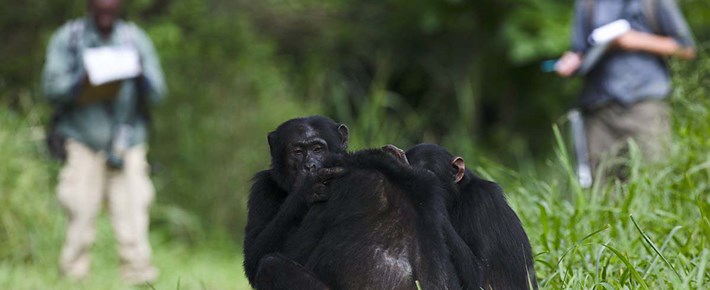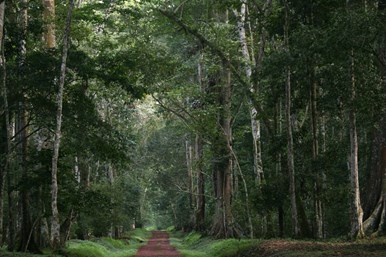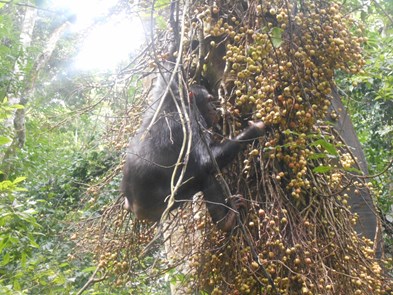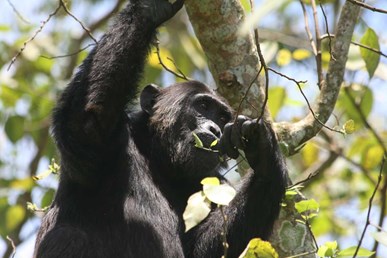News
Using forest research to inform chimpanzee conservation in Budongo
May 26, 2016

At BCFS, the value we attach to scientific research in informing conservation practices as well as informing policy is immeasurable. As such, we support research at various fronts including junior research fellows among others that are supported by the project to carry out their MSc. research projects in Budongo. In this article we present some of the recent findings by one of our junior research fellows Nyombi Herbert who completed his research and graduated with a Master of Science in Environment and Natural Resource Management at Makerere University, Kampala on the Implications of the variations in tree fruiting phenology under climate change on primate foraging patterns in and around Budongo Forest Reserve.

In any ecosystem including tropical forests among others, almost every single component depends on the other. For instance, primates with specific focus on monkeys and the endangered chimpanzees in this study depend on the forest trees as their major source of food. This is mainly inform of fruits, leaves, flowers and buds which are a delicacy. Consequently any decline in food supply within the forest would force these primates to look for alternative food sources both within and/or outside the forest. Due to observed declines in the number of fruiting trees in Budongo Forest Reserve (BFR), I found it intriguing to investigate how the decline in fruiting would affect primate foraging behaviors and patterns in and around Budongo with an aim of investigating the changes in tree fruiting phenology under changing climatic conditions. A hypothesis that changes in climatic variables especially temperature and rainfall could be the cause of reduced tree fruiting was made.
Over 7300 individual trees belonging to 97 tree species out of 465 tree species in BFR in the different forest compartments were monitored by conducting monthly visits to record whether they were fruiting or not. To investigate the primate foraging patterns, habituated monkey groups (Cercopithecus mitis, Cercopithecus ascanius and Colobus guereza) were observed to record their dietary composition. In addition to these, surveys were conducted among forest edge communities to assess the current spatial and temporal crop raiding patterns in relation to the past crop raiding patterns.
From the analysis, tree phenology patterns showed continued reduction in the number of fruiting trees among the different forest compartments despite the difference in their historic management regimes. Results further indicated spatial differences in fruiting patterns with more in compartments comprising the primary forest types compared to compartments comprising secondary forest types. Climatic variability also had a significant impact on tree fruiting. More fruiting was recorded at the end of rainy seasons (May) where the lowest minimum temperatures were also recorded. Tree fruiting drastically reduced and often trees never fruited when there was no rainfall and temperatures went too high.

A comparison of primate foraging patterns indicates that whereas fruits constituted over 60% of primate diet in the early 1990's, there has been a gradual shift to leaves as the main diet (over 45%) over the years. In addition, majority of the forest edge community members (64%) agree that crop raiding around BFR has increased over the last 15 years both in frequency and intensity. Furthermore new crop raiding primate recruits have been reported for example, previously non raiding primates like chimpanzees were reported by farmers as currently one of the major raiders of maize and sugar cane in communities around Budongo. It was noted that reduction and differences in forest trees fruiting directly correlated positively with rainfall, minimum temperature and forest structure. In addition, reduction in fruiting has led to diet shifts among frugivorous monkeys from fruits to leaves, fruit availability or scarcity within the forest did not seem to have any direct impact on crop raiding behaviors of primates.

This calls for paradigm shift in management and conservation of BFR so as to cater for the new raiding behaviours of primates especially monkeys, baboons and chimpanzees so as to control the animosity of humans living around the forest towards the crop raiding primates and other forest fauna. There is also a need for more intense studies on the impacts of changes in tree phenology on other forest ecosystem components such as herbivores, pollinators and seed dispersers. Further more, due to reduced tree fruiting, management strategies for primate survival in BFR should consider within forest food enhancement while reducing conflicts with local communities. Lastly responsible bodies such as National Forestry Authority (NFA) and local conservation agents like Budongo Conservation Field Station (BCFS) should undertake an integrated approach towards primate conservation involving the local people because they are directly affected by living alongside wildlife so as to ensure conservation of primates amidst the forest neighbouring human communities whose attitude towards conservation is often tainted by the losses they incur as a result of crop raiding.
This work was made possible through the generous support and funding by Earthwatch Institute and START.

Nyombi Herbert
Junior Research Fellow, BCFS
Latest Articles
-
Launch of the “Budongo: Livestock for Conservation” Pilot Project
October 21, 2025
-
Revitalizing ornithology research at BCFS
November 30, 2024
-
Perspectives Collective Journal Launch
February 21, 2024
-
Snares are major threat to juvenile chimps in Budongo
November 25, 2022
-
Albino infant chimpanzee sighted in Sonso
September 07, 2021




